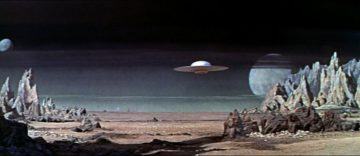by Bill Benzon
When I was growing up in the 1950s and 1960s Westerns were pervasive on television and at the movies. Where they the dominant genre of the era? Perhaps, I don’t really know. But whatever the numbers say, the were very important. Correlatively, science fiction was a relatively minor genre, both on television and on the big screen. Now the situation is reversed. Science fiction is pervasive while Westerns, if not as scarce as hens teeth, certainly do not command the broad attention they once did.
What are we to make of this? Westerns look to the past, to the founding of America. How the West Was Won (1962) was the story of America, and it won three Academy Awards. The bespeak and confident America. Star Trek is a bit different. It, the entire franchise (from 1966 through to the present), is set in the future while America has only a tenuous presence in it, a step back in time every now and then. America is in transit. Similarly, Star Wars, the whole throng of stories, is set in a universe long ago and far away. America has disappeared.

Why? Tastes change, no? Yes, but why? For one thing, America has changed as well. That’s what interests me, the relationship between changes in America and changes on the Big Screen. I want to examine that by focusing on two films, The Forbidden Planet (1956), a science fiction classic from the era when science fiction was a minor genre, and The Terminator (1984), another classic science fiction film, one in a franchise in an era of franchises, and an era when science fiction was becoming pervasive.
The argument I am going to make, a loose argument, a speculative argument, and therefore the most interesting kind of argument we can make about the stories we tell ourselves, is that these are, at the core, the same story. If they are, on the surface, so very different – which they are – that is because they speak to radically different psycho-cultural circumstances. The America of 1956 was confident of itself and of the future. The America of 1982 was badly shaken and searching for itself. Exactly between those two dates, 26 years apart, we have the Apollo moon landing in 1969. Read more »
